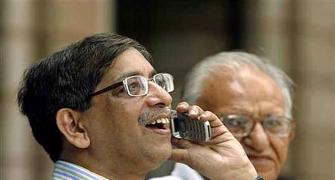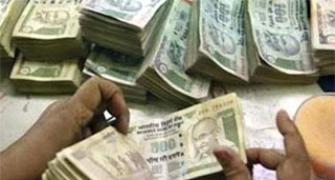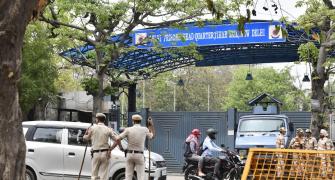After the Budget deferred fiscal consolidation by a year, it was interesting to gauge the response of rating agencies. Atsi Sheth (bottom, left), senior vice president Moody's Investors Service, tells Indivjal Dhasmana that the Budget has not changed the rating agencies views on India's sovereign rating. Moody's has assigned India the lowest investment grade. She says Moody's has already taken into account India's higher growth and lower fiscal deficit compared to similarly rated peers. It takes into account the entire country's fiscal situation and not the Centre's alone, she says. Excerpts:

Will the Budget move to relax fiscal consolidation road map by a year impact India's sovereign rating?
Our view on India’s sovereign credit profile incorporates our expectation that India’s growth will remain above that of similarly rated peers, and government finances will remain weaker than similarly rated peers. The measures in the Budget indicate that this expectation will be borne out over the coming year, therefore it doesn’t change our view on India’s sovereign credit profile.
 Gross tax revenues (before states devolution) were short of over Rs 1 lakh crore in 2014-15. Do you think the target of 15.83 per cent increase in these revenues 2015-16 against close to 19 per cent in the previous year is bit of caution by the government?
Gross tax revenues (before states devolution) were short of over Rs 1 lakh crore in 2014-15. Do you think the target of 15.83 per cent increase in these revenues 2015-16 against close to 19 per cent in the previous year is bit of caution by the government?
Over the past few years, optimistic revenue and growth assumptions necessitated expenditure reductions in the latter half of the fiscal year. Given current indicators, the Budget’s growth assumptions appear to be closer to what will be realized. Even with a lower projected growth rate in revenues, the Budget still assumes revenue buoyancy, ie that government revenues will pick up as growth does. But this depends to some extent on profitability – which has yet to recover. So while we also expect government revenues to rise, they will depend on how profitable economic activity is over the next year.
Before the Budget, Moody's had said reforms will determine India's credit profile. Has the Budget passed that test?
The Budget clearly prioritized growth over fiscal consolidation. On the one hand, the Budget contains several measures that are positive, such as clarity around GAAR, a simplification of the corporate tax regime, reiteration on the timing of introducing the goods and services tax, an emphasis on infrastructure investment and greater efficiency in the subsidy system, via direct cash transfers. On the other hand, there was no significant reduction of current expenditures, the fiscal roadmap announced last year was changed and fiscal consolidation delayed.
We have noted in the past that fiscal consolidation is difficult in India due to structural rigidities – i.e. the flexibility to expand the revenue base is limited because of generally low per capita incomes, and some current expenditures are similarly difficult to roll back for social, political reasons. The increase in next year’s deficit to 3.9% of GDP from 3.6% and the delayed reduction of the fiscal deficit to 3% of GDP simply underscores our view.
What kind of reforms are you looking at since the Economic Survey clearly said that big-bang reforms generally happen in the crisis period?
We agree that in India, policy change is more likely to proceed incrementally than with a so-called ‘big bang’. And, rather than big bang policy announcements, it is policy implementation that will determine macro-economic outcomes.
As the Budget has shown, fiscal consolidation in India is difficult, even at a time of accelerating growth and benign oil prices, due to the structural rigidities mentioned above. But if you look at India’s fiscal history, higher growth between 2003 to 2008 clearly benefited government finances through higher revenues.
That period was also marked by an increase in the private savings and investment rate, an improvement in productivity, profitability and at least for part of that period, benign inflation. Therefore, if a similar macro-economic balance– higher growth, low and stable inflation, rising savings and investment rates – is sustained over an extended period, it would also benefit government finances, as long as government expenditure growth is also checked.
Many of the policies to achieve and sustain such a balance are already in place, or have been announced. Whether they are successful will depend on the pace and efficiency of their implementation.
Do you think that the growth rate of 8.1-8.5 per cent projected by the Economic Survey for 2015-16, fits into India's credit rating of lowest investment grade?
In the past decade, India often achieved a growth rate even higher than that projected by the Economic Survey for the coming year. However, growth is not the only determinant of the sovereign credit profile. Other factors, such as government finances, inflation, bank asset quality, ease of doing business and infrastructure also determine the sovereign credit profile – and on all these metrics, India’s performance is relatively weak compared to similarly rated peers.
For instance, India’s general (state + central) government fiscal deficit are well above those of most sovereigns in our rated universe. – and will likely remain so, even when the central government deficit drops to 3% of GDP.
Subsidies are projected to come to 1.6 per cent of GDP in 2015-16 from 2 per cent in 2014-15. Is this the direction that Moody's has in mind?
In so far as subsidies reduce current expenditure, the reduction would benefit India’s fiscal profile. However, part of this reduction is due to lower commodity prices. In terms of policy, the Budget gave greater weight to increasing efficiency in delivery of subsidies, than on cutting subsidy expenditure itself.
The implementation of this process is much more important than the announcement. For instance, looking ahead over the medium to long term, the weight of food subsidy expenditure is likely to increase, unless efficiency in food production and distribution is significantly improved.
Budget has deferred GAAR by two years and clarified what constitutes indirect transfer of taxes. Do you think that will make India an attractive destination for investment?
These measures, in addition to the announcement on corporate tax reduction/simplification and the plan to introduce GST in 2016 , should incentivize both domestic and foreign investment in India. The extent of investment acceleration will also depend on other measures to increase the ease of doing business in India.










